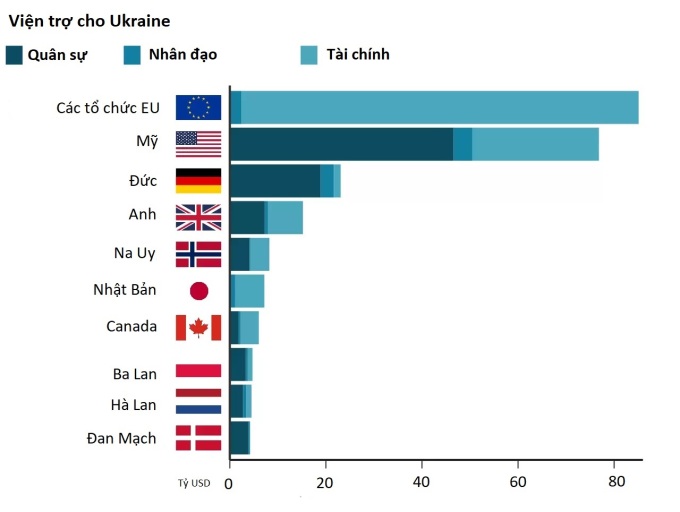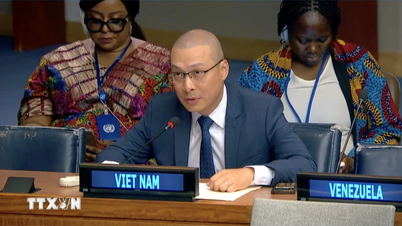The United States is the largest aid donor to Ukraine, but growing public and congressional opposition could make it difficult for Washington to increase support for Kiev.
Aid to Ukraine is one of the biggest budget issues between the White House and the US House of Representatives. The Biden administration wants any budget bill to include $24 billion in military and humanitarian aid to Ukraine, while hard-line Republicans in the House of Representatives are adamantly opposed, putting the US government at risk of a shutdown.
ABC News released a survey conducted with the Washington Post on September 25, showing that 41% of respondents said the US was doing too much to support Ukraine, up from 33% in February and 14% in April 2022. Half of respondents said the US was doing enough or too little, compared to 60% last month and 73% in the early months of the war.
These realities could make it more difficult for President Biden to increase support for Ukraine, in the context that Washington has spent more than $100 billion to help Kiev in the war with Russia, becoming the largest supporter.
As Ukrainian President Volodymyr Zelensky made his second visit to the United States on September 21 to drum up support for a $24 billion aid package, Republicans grew increasingly skeptical of the conflict-busting aid effort. House Speaker Kevin McCarthy rejected a request for a joint session of Congress so Zelensky could address lawmakers.

The US Air Force loads military aid equipment for Ukraine onto a transport plane at Yokota Air Base, Tokyo, Japan, in March 2022. Photo: AFP
Over the past year and a half, President Biden has taken a firm stance on US aid. The US Congress has so far approved $110 billion in aid to Ukraine, including $49.6 billion in military aid, $28.5 billion in economic aid, $13.2 billion in humanitarian assistance, and $18.4 billion to strengthen US defense industry capacity to maintain arms supplies to Kiev.
The White House says it has spent 91 percent of the aid it has allocated. The administration is now asking Congress to approve an additional $24 billion, including $14 billion in military aid. But declining support for more aid from Americans and opposition from Republicans make the package uncertain.
Alyssa Demus, an international defense researcher at the RAND Corporation, said that without additional aid, Ukraine’s offensive could stall for weeks, sending a negative signal to Kiev, which has been making some encouraging progress on the battlefield.
As winter approaches, Ukraine will have to scale back its military operations regardless of whether US aid arrives, Demus said. But he said a new US aid package would have a larger impact beyond the battlefield.
"The US tends to be a model for other countries in supporting Ukraine. If the US does not act, European allies and partners may reconsider their ability to provide aid to Kiev," she said.

The 10 biggest donors to Ukraine as of August 2023. Graphics: BBC
Despite the Biden administration's steadfast stance on additional aid to Ukraine, a growing number of Republican politicians are taking a hard line on the operation.
“We don’t have a national interest in Ukraine. Even if we did, it’s outweighed by the fact that we don’t have any money,” Senator Rand Paul said.
Senator Josh Hawley also said he was tired of the White House's requests for additional aid funding. "It's not our money. It's the American people's money," he said.
The prevailing view among a growing number of Republicans is that the US budget should be focused on other priorities, especially domestic issues such as border security, disaster relief and crime control, rather than spending on Ukraine.
US aid to Ukraine is small compared to the $751 billion the country will spend on defense in 2022, or the $1.2 trillion it will spend on Social Security retirement benefits. Aid to Kiev also represents just 1.8% of total US spending in fiscal year 2022.
But the nearly $80 billion in aid as of the end of July is larger than the annual budgets of many federal agencies.

US budget for Ukraine compared to federal agencies in 2023. Graphic: BBC
Many Americans believe allies should shoulder more of the burden of the war. “Europe needs to do more. Our support should be contingent on them doing that,” Florida Governor Ron DeSantis said at a debate in Wisconsin last month.
The US contributes more military aid to Ukraine than its allies, but in terms of total aid, European countries, individually and within the EU, have pledged $140 billion to Ukraine.
Luke Coffey, a senior fellow at the Hudson Institute, said that comparisons based on the actual amount of money countries spent on Ukraine do not accurately reflect the role of US partners and allies.
“You can’t compare what the US is doing in Ukraine to what countries like Estonia are doing. This European country has an economy the size of Vermont,” he said.
Coffey believes the best comparison is based on the ratio of aid to GDP. According to data from the Kiel Institute for the World Economy, Norway had the highest ratio of aid to GDP as of the end of July, at 1.71%. Lithuania, Estonia and Latvia were next, all at more than 1%.
Still, Republicans say the US has already paid too much. Rand Paul, a Republican senator from Kentucky, has said he would block any new government funding bill that includes aid to Ukraine.
"I have informed congressional leadership and President Biden that I will not agree to any budget package that includes additional US aid to Kiev," Paul announced on Twitter.
Thanh Tam (According to BBC )
Source link





























































































Comment (0)